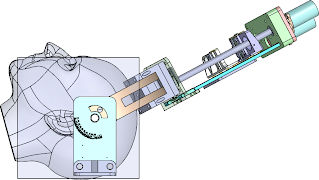MR-Conditional Robots for Neurosurgery
MR-guided robotic therapy is nowadays a growing technology to automatically plan, navigate, monitor and control the surgical devices to the target position inside the MRI room. In this project, we look into novel bi-directional and fast pneumatic motor design that can be integrated into MR conditional robots for tele-operable real-time surgical tools for neurosurgery.
The strong magnetic field of MRI scanner precludes the application of conventional electro-mechatronic motors that are made from ferromagnetic or para-magnetic materials. The introduction of direct current motors not only poses a dangerous risk to a patient by the strong magnetic force generated by the scanner but also adversely affects the image quality caused by the distorted static and gradient magnetic field.
Pneumatic actuation is a promising alternative to provide MR-conditional actuation since its working principle is electromagnetically decoupled from MR scanner. Instead of driving by electricity, pneumatic actuator utilizes compressed air as the energy source, which is a standard configuration in the MR room. To date however, the pneumatic actuation in MR room was limited to stepper motors and piston type actuators. We propose a novel continuous bi-directional pneumatic motor with fiber optical encoders. Fig 1 shows the concept robot design of this ongoing research where the telerobot will then be mounted on the aiming frame to aim the needle size tools towards any desired location.

Fig 1: The prototype robot concept in CAD drawing

The proposed motor actuation and feedback circuitry were then attached to a Matlab XPC (Matlab real-time now) target machine and PD controller was implemented. the evaluation carried out in MR showed that the proposed motor created minimal image artifacts in MR images (Fig 2).
We are currently extending the pneumatic motor actuators in a neurosurgical robot. The robot consist of two components: MR conditional aiming and tele-robotic device. The aiming device was designed such that it can cover the entire human cranial space. The workspace was identified after analyzing 20, real patience CT scans obtained from Vanderbilt hospital. Applications include intra-cerebral hemorrhage evacuation, deep brain stimulation applications. The ongoing development of the robot is shown in Fig 3.
Fig 2: Testing pneumatic motors in MR scanner.

Fig 3: The ongoing robot development of the MR conditional robot
Publications
- Y. Chen, Isuru S. Godage, Z. T. H Tse, R. J. Webster III, and E. J. Barth. “Characterization and Control of a Pneumatic Motor for MR-conditional Robotic Applications” IEEE/ASME Transactions on Mechatronics (TMECH), PP(99), 2017, pp. 1-10
- Y. Chen, M. E. Poorman, D. B. Comber, E. B. Pitt, C. Liu, Isuru S. Godage, H. Yu, W. A. Grissom, E. J. Barth, and R. J. Webster III, “Treating Epilepsy via Thermal Ablation: Initial Experiments with an MRI-Guided Concentric Tube Robot”, in Design of Medical Devices (DMD) Conference, 2017, pp. V001T02A002.
